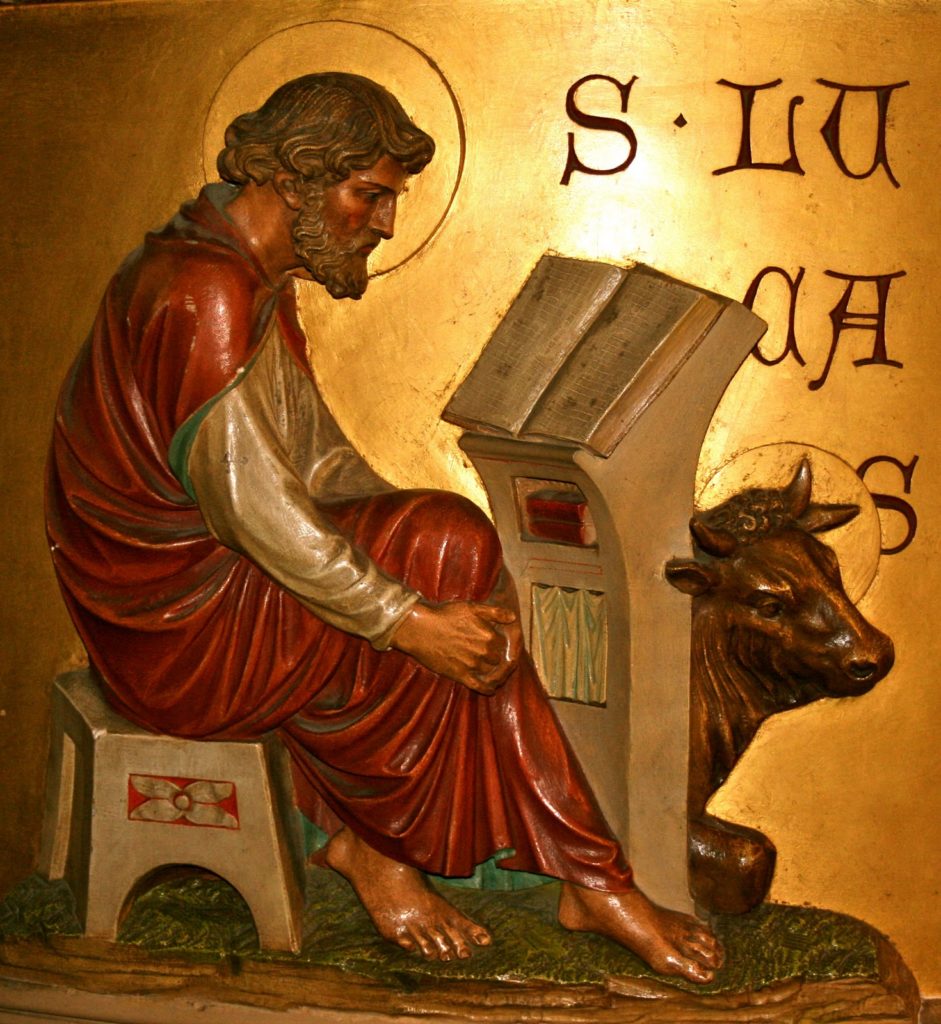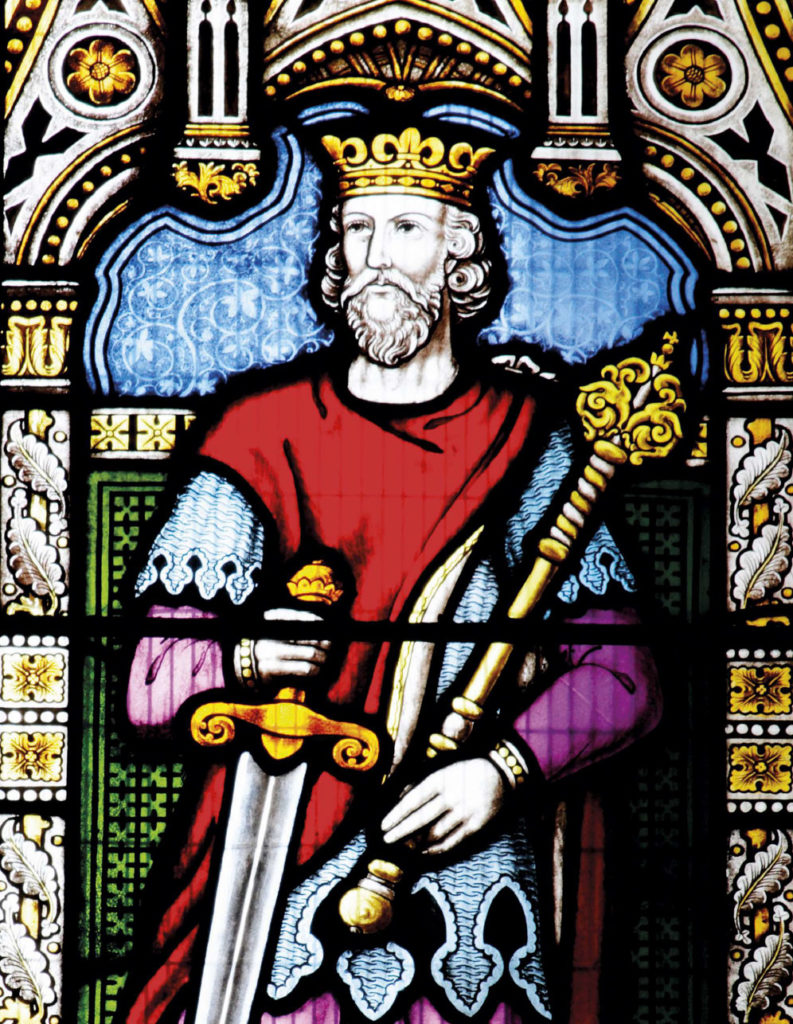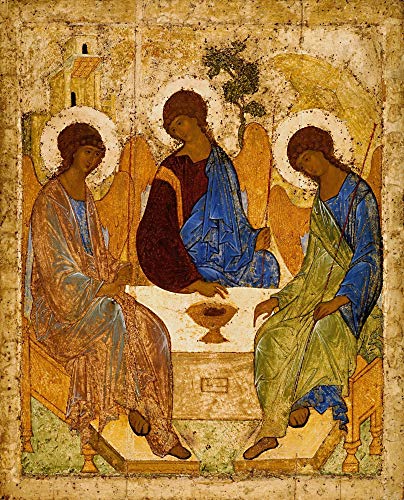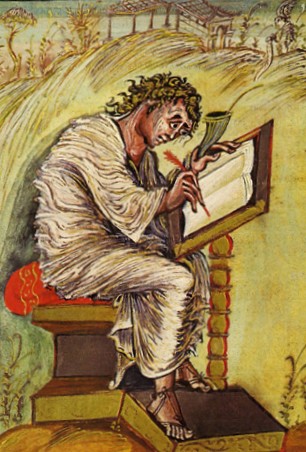
St. Luke, Evangelist
Sirach 38:1-4, 6-10, 12-14
Psalm 147
2 Timothy 4:5-13
Luke 4:14-21
Click here to access these readings.
Today is the feast day of St. Luke, the third evangelist. St. Luke is known as being a physician and for setting his gospel account firmly in history. He is often represented (as he is in the picture above) by a winged ox. This may seem a little odd (what do oxen have to do with doctors or writing?), but, in fact, all of the gospels are traditionally represented by some similar figure. Matthew’s gospel is the “winged man”, Mark’s is the “winged lion”, and John’s is the eagle. Each of these represents some important aspect of their gospel account. Matthew’s gospel, for instance, begins with Jesus’s genealogy (and so his specifically human descent), and so the “winged man” is appropriate. The eagle, according to tradition, had such good eye-sight that it could look directly into the sun, and this bird was seen as a fit symbol for St. John’s gospel. The wings of each symbol represent their ability to ascend beyond the normal, work-a-day world; the gospels are not just simply accounts of Jesus’s life (called vita in the ancient world), but holy Scripture. They are the Word of God, and, at the same time, they are grounded in the life of Jesus in this world.
These symbols were not thought up in the first century A.D. but were, instead, drawn from Scripture. In the beginning of the book of Ezekiel, the prophet sees a magnificent vision. And in this vision, he sees:
“As I looked, a stormy wind came out of the north: a great cloud with brightness around it and fire flashing forth continually, and in the middle of the fire, something like gleaming amber. In the middle of it was something like four living creatures. This was their appearance: they were of human form. Each had four faces, and each of them had four wings. Their legs were straight, and the soles of their feet were like the sole of a calf’s foot; and they sparkled like burnished bronze. Under their wings on their four sides they had human hands. And the four had their faces and their wings thus: their wings touched one another; each of them moved straight ahead, without turning as they moved. As for the appearance of their faces: the four had the face of a human being, the face of a lion on the right side, the face of an ox on the left side, and the face of an eagle; such were their faces.” (Ezekiel 1:4-10b)
Early Christian writers, and tradition thereafter, saw in this image a foretelling of the Christian Scriptures and, especially, the four gospel accounts. These four symbols are seen again in Revelation (4:6-8). Tradition pulled from both these sources and, ever afterwards, depicted each gospel by these four, winged beings.
So, what’s with the “winged ox”? The ox was an animal of sacrifice, and so it represents both the priestly order that completed sacrifices but also the sacrificial victim. And in St. Luke’s gospel we find many stories about sacrifice and the priestly vocation of Jesus. In the ancient world, sacrifice was done to re-establish a person or community’s relationship with God. Jesus Christ, however, took these sacrifices upon himself and made a lasting and eternal relationship with His Father, ending the need for other sacrifices. St. Luke’s gospel explains this idea through its parables and stories about and around Jesus, and so tradition associated him with the symbol of the ox.
If all this talk of sacrifice is getting you down, think of it this way: one of the collects for mission during Morning Prayer (and often reserved for Friday) is the following:
Lord Jesus Christ, you stretched out your arms of love on
the hard wood of the cross that everyone might come within
the reach of your saving embrace: So clothe us in your Spirit
that we, reaching forth our hands in love, may bring those
who do not know you to the knowledge and love of you; for
the honor of your Name. Amen.
Jesus, we believe, went to Calvary without complaint, because He knew what His sacrifice would do for the people of the world. Jesus went to the cross in pain, surely, but out of love. And we who follow him, how much do we hope to sacrifice out of love? Parents give up a great deal for their children; teachers work long hours for their students; soldiers leave their homes to defend their country. In St. John’s gospel, we hear “There is no greater love than to lay down one’s life for one’s friend” (15:13). Jesus upon the cross was of pain, surely, but it was also of a dedicated love that we can only hope to emulate.
May we all live a life dedicated to the love of others, as Jesus did before us.




